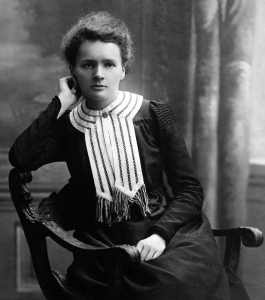My third selection of ‘formidable women’ is Marie Curie, who had been honoured by none other than François Mitterrand, the 21st and longest-serving President of France (1981 until 1995) with the reburial of her and her husband’s bodies under the dome of the Panthéon, as he said, “in order to finally respect the equality of women and men before the law and in reality” (“pour respecter enfin….l’égalité des femmes et des hommes dans le droit comme dans les faits”). Mitterrand’s gesture was of particular note not only because Marie Curie was being honoured for helping to increase the prestige of France in the scientific world, but because she was an immigrant, and perhaps most importantly, because she was a woman.
Marie Sklodowska, as she was known before marriage, was born in Warsaw in 1867. Although shy and introverted, she had a brilliant aptitude for study and a thirst for advanced knowledge, but at that time as a woman, the opportunity for higher study was not available in Poland. She worked for several years to save enough money to send her elder sister, Bronya, to the Sorbonne in Paris to study medicine, and Bronya in her turn, once she had earned her degree, contributed to the cost of Marie’s studies. Finally, at the age of 24, Marie left Poland to study mathematics and physics at the Sorbonne. “It was like a new world opened to me, the world of science, which I was at last permitted to know in all liberty,” she wrote.
Marie was at the top of the list of candidates when she took her degree in physics in 1893 and the next year, came second in mathematics. Her ultimate goal had been to take a teacher’s diploma after three years of exceptional results in physics and mathematics and to return to Poland to teach. However, as fate would have it, she met Pierre Curie, an internationally renowned physicist at the age of 35, devoted to a life of scientific work, particularly in the research of crystals and the magnetic properties of bodies at different temperatures. This meeting would change Marie’s planned direction in her own life.
Marie and Pierre, intellectually compatible, married in 1895. In 1896, Marie received her teaching diploma, at the top of her group. Their daughter Irène was born in September 1897. And at that time, having concluded several investigations into the magnetic properties of steel in the laboratory of the School of Industrial Physics and Chemistry of which Pierre was the head, she settled on a systematic investigation into the mysterious “uranium rays” as initially presented by Röntgen and Becquerel, as a basis for her doctoral thesis.
After years of heavy, exhausting work, Marie finally presented the results of her work in her doctoral thesis in physics on June 25, 1903, deemed by the assessing committee to represent the greatest scientific contribution ever made in a doctoral thesis. And in that same year, Marie and Pierre shared in the Nobel Prize in Physics. The prize alleviated their financial difficulties, but unfortunately, neither Marie nor Pierre knew then of health threats posed by the materials they had been working with.
On April 19, 1906, Pierre Curie was run over by a horse-drawn wagon in Paris and killed, but even though the demure Marie was devastated, and left to raise two young daughters on her own, she proceeded to realize a number of highly recognized accomplishments, including being awarded the Nobel Prize in Chemistry in 1911 for her discovery and isolation of radium which was considered by chemists to be the greatest event in chemistry since the discovery of oxygen, and opened up a completely new field of research: radioactivity.
From there, Marie continued to conduct her research and produce new discoveries in the fields of physics and chemistry, but she also endured, and overcame, the condemnation that comes of gender bias. In the last ten years of her life, Marie had the joy of seeing her eldest daughter and her son-in-law discover the means to achieve artificial radioactivity, but did not hear that they had been awarded the Nobel Prize in Chemistry in 1935. Marie Curie died of leukemia on July 4, 1934.



What a fascinating life she had; this woman is truly an inspiration. 🙂
LikeLike
I feel women like Marie Curie should be revisited in order to inspire women of today. 🙂
LikeLiked by 2 people
I couldn’t agree more. 🙂
LikeLiked by 1 person
Reblogged this on Crazy Pasta Child.
LikeLike